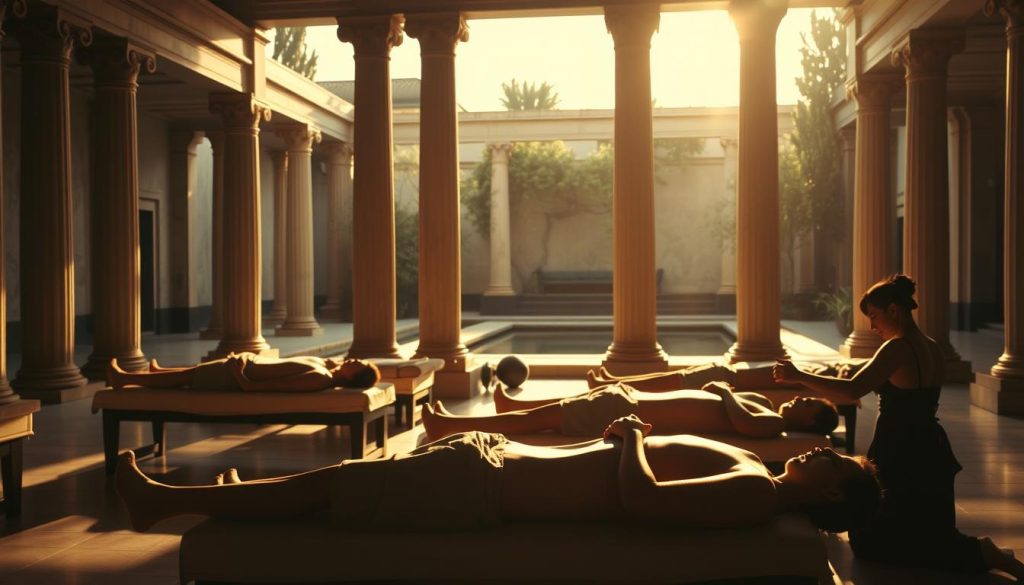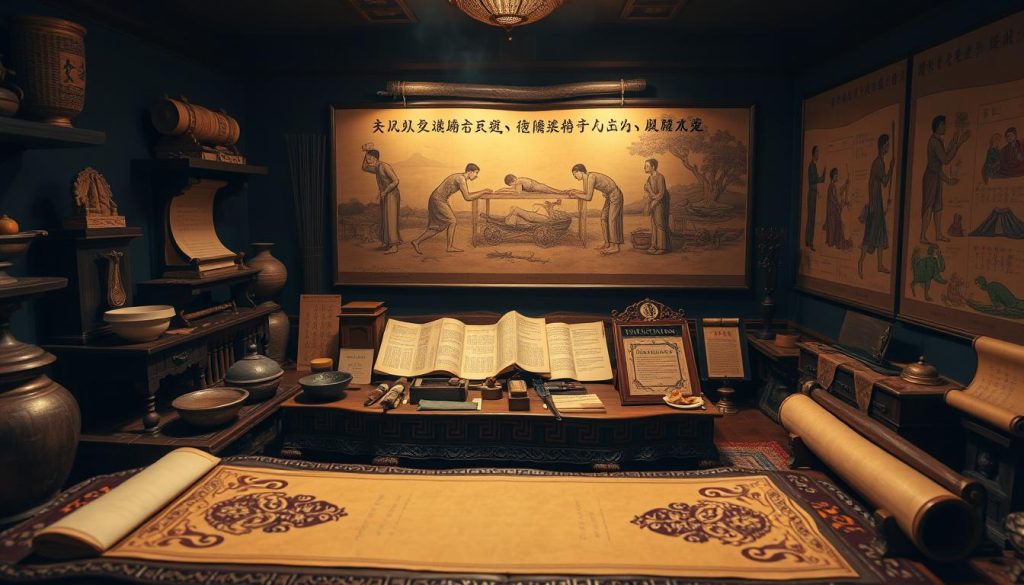Ever wonder if that luxurious spa massage you love has deeper roots than just modern relaxation? What if this practice has been cracking backs and soothing minds for over 5,000 years across various civilizations?
Massage therapy isn’t some new-age fad. Ancient cultures from India to Egypt were already mastering bodywork techniques while building pyramids and developing early medicine. These practices focused on healing, pain relief, and balancing energy long before scientific research confirmed their benefits.
Hippocrates, the famous physician, even prescribed massage for injuries. His support helped shape Western medical practices. Through centuries, different regions developed unique approaches—from China’s Tui Na techniques to Japan’s Anma method.
This rich history shows massage has always been about more than just feeling good. It represents human ingenuity in healing and wellness across time and cultures.
Key Takeaways
- Massage therapy dates back over 5,000 years to ancient civilizations
- Multiple cultures developed unique massage techniques independently
- Early practices focused on healing and energy balance
- Hippocrates incorporated massage into Western medical tradition
- Traditional methods evolved into modern therapeutic practices
- Massage has consistently addressed both physical and mental wellness
- Historical practices inform today’s massage therapy approaches
The Historical Journey Begins: Ancient Massage Origins
Picture this: ancient civilizations developing sophisticated bodywork techniques while modern medicine was still in its infancy. These early innovators created healing practices that would shape wellness for millennia.
Massage therapy wasn’t just about relaxation. It formed crucial parts of medical systems across cultures. Each region developed unique approaches to healing through touch.
India’s Ayurvedic Foundations (3,000 B.C.E.)
India gave us Ayurvedic massage around 3,000 B.C.E. This practice used warm herbal oils and aromatherapy. It aimed to balance your body’s doshas—your fundamental energies.
Written records appeared between 1,500-500 B.C.E. These texts described holistic approaches combining massage with meditation. The goal was complete mind-body harmony.
Ancient Indians understood something modern science now confirms: touch therapy affects your entire being. Their methods addressed both physical and spiritual wellness.
China’s Energy Balancing Act (2,700 B.C.E.)
China developed massage methods by 2,700 B.C.E. as part of Traditional Chinese Medicine. Practitioners focused on Qi energy flow through your body’s meridians.
They believed blocked energy caused pain and illness. Massage techniques aimed to unblock these pathways. This philosophy led to acupressure and acupuncture.
The Chinese approach viewed your body as an interconnected system. Treatment addressed root causes rather than just symptoms.
Egypt’s Reflexology Revelations (2,500 B.C.E.)
Ancient Egypt pioneered reflexology around 2,500 B.C.E. Tomb paintings show practitioners working on hands and feet. They believed specific points connected to entire body systems.
Egyptians developed sophisticated understanding of body interconnectedness. Their techniques recognized that foot massage could affect organs throughout your body.
This wasn’t mere speculation—hieroglyphics document these practices as legitimate medical treatments. They left visual records that still inform modern therapy.
Japan’s Adaptation of Eastern Techniques (1,000 B.C.E.)
Japan adapted Chinese Tui Na massage into Anma by 1,000 B.C.E. This early form of Shiatsu focused on improving blood flow and reducing stress.
Japanese practitioners refined techniques to suit their culture’s needs. They developed methods that combined pressure points with stretching.
This adaptation showed how massage practices evolve across borders. Each culture adds its unique perspective to healing traditions.
| Civilization | Time Period | Key Contributions | Modern Influence |
|---|---|---|---|
| India | 3,000 B.C.E. | Ayurvedic principles, herbal oils, dosha balance | Modern aromatherapy massage |
| China | 2,700 B.C.E. | Qi energy concept, meridian theory | Acupressure and acupuncture |
| Egypt | 2,500 B.C.E. | Reflexology maps, pressure point therapy | Modern foot reflexology |
| Japan | 1,000 B.C.E. | Anma technique, adapted Chinese methods | Shiatsu and pressure point therapy |
These ancient practices demonstrate remarkable innovation. Early practitioners developed sophisticated bodywork without modern technology. Their legacy continues in today’s massage therapy sessions.
Each culture contributed unique insights to the art of healing touch. From India’s holistic approach to Egypt’s reflexology, these methods formed the foundation of modern massage practices worldwide.
From Greek Gymnasiums to Roman Baths: Classical Development
Imagine ancient athletes getting pre-game rubdowns before Olympic competitions. That’s exactly what happened in classical times. Greeks and Romans took bodywork to new heights.
They transformed massage from spiritual practice to athletic and medical treatment. This era created foundations for modern physical therapy approaches.

Greek Athletic Innovation (800-500 B.C.E.)
Greek athletes pioneered sports massage around 800-500 B.C.E. They needed peak performance for Olympic games. Trainers developed techniques to relieve muscle knots.
These early massage practitioners understood muscle function. They used kneading and pressure to prevent injuries. Their methods reduced pain and improved recovery time.
Gymnasiums became centers for bodywork innovation. Athletes received regular treatments as part of training. This was the birth of sports therapy.
Hippocrates’ Medical Endorsement
Hippocrates changed everything in the 5th century B.C.E. The famous physician prescribed massage for injuries. He called it “anatripsis” – meaning rubbing upward.
His friction technique used intense pressure on muscle tissue. This treatment addressed deep knots and circulation issues. Hippocrates wrote detailed records of his methods.
“The physician must be experienced in many things, but assuredly in rubbing.”
This medical endorsement legitimized massage therapy. It became part of Western medicine’s foundation. Hippocrates showed how touch could heal the body.
Roman Adoption and Refinement
Romans loved Greek ideas – especially their massage practices. They adopted and enhanced these techniques. Roman baths became wellness centers.
They added luxurious oils and aromatics to treatments. Massage became part of social and medical culture. Physicians used it for various health conditions.
Romans documented therapeutic benefits in medical texts. Their approach combined Greek techniques with their own innovations. This created comprehensive treatment protocols.
The Medieval Decline and Eastern Preservation
Massage therapy faced challenges in medieval Europe. Cultural shifts reduced its medical acceptance. Many Western practices faded during this time.
Fortunately, Eastern cultures preserved these healing arts. Middle Eastern and Asian practitioners continued developing techniques. They maintained detailed records of their work.
This preservation ensured massage’s survival through difficult centuries. Eastern innovation kept bodywork evolving while Europe temporarily forgot its value.
Classical innovators created lasting foundations for modern massage therapy essentials. Their work shows how ancient practices inform today’s treatments.
The Modern Massage Revolution: From Sweden to Your Spa
Think your favorite spa treatment just appeared yesterday? Think again. The 19th century brought massage into the modern era with scientific precision and systematic approaches.
This period transformed ancient healing arts into structured therapeutic practices. Science finally met soothing strokes in ways that would shape today’s wellness industry.
Swedish Massage: Science Meets Relaxation
Per Henrik Ling revolutionized bodywork in the early 1800s. His Swedish system used specific strokes, kneading, and tapping techniques. This method focused on improving circulation and relaxation.
Some credit Johann Mezger for popularizing French terms for movements. Effleurage, petrissage, and tapotement became standard vocabulary. These techniques form the foundation of modern Western massage.
The Swedish approach combined anatomy knowledge with therapeutic touch. It created the first truly systematic method for bodywork. This became the template for contemporary massage therapy.
America’s “Rubbers” and Medical Integration
America had its own massage pioneers in the 18th century. They were called “rubbers” – yes, that was their actual job title. These practitioners assisted doctors with manual therapies.
Rubbers helped patients recover from various conditions using skilled hands. They worked with physicians to address neurasthenia and other ailments. Their work showed early integration of massage into healthcare.
This period demonstrated massage’s value in medical settings. It wasn’t just about luxury – it was legitimate treatment. Rubbers paved the way for today’s professional massage therapists.
“Massage is the oldest form of medical care, and its integration into modern medicine represents a full-circle moment in healthcare history.”
20th Century Professionalization
The 1900s brought massive changes to massage practice. Professional organizations like the AMTA formed standards. This made massage a legitimate career path with proper training.
Modern Registered Massage Therapists now complete 3,000+ hours of training. They study anatomy, physiology, and pathology alongside traditional techniques. This education ensures safe, effective treatments for clients.
Massage became integrated into hospitals and healthcare systems. It moved beyond spas into medical recovery programs. This professionalization elevated massage to respected therapeutic status.
Contemporary Modalities and Techniques
Today’s massage scene offers incredible variety. Ancient wisdom meets modern science in countless modalities. From deep tissue to hot stone, innovation continues thriving.
Scientific research now validates what ancient cultures knew instinctively. Studies show massage reduces pain, lowers stress, and improves overall health. PubMed contains thousands of studies confirming therapeutic benefits.
Modern techniques address specific needs with precision. Whether you need sports recovery or stress relief, there’s a modality for you. Contemporary practice combines centuries of wisdom with current research.
| Time Period | Development | Key Figures | Modern Impact |
|---|---|---|---|
| 19th Century | Swedish system development | Per Henrik Ling | Foundation of Western massage |
| 18th Century | American “rubbers” | Early practitioners | Medical integration |
| 20th Century | Professional organizations | AMTA founders | Standardized training |
| 21st Century | Research-backed modalities | Contemporary researchers | Evidence-based practice |
Your monthly massage appointment connects you to this rich history. Centuries of innovation led to that perfect pressure point technique. Modern practice blends old-school wisdom with new-school science.
Today’s massage techniques offer something for everyone. From stress reduction to pain management, therapeutic benefits are now scientifically validated. This revolution makes ancient healing arts accessible in modern times.
The journey from Swedish systems to contemporary practice shows constant evolution. Massage continues adapting to meet human needs across centuries. Your wellness benefits from this ongoing innovation.
Conclusion: Your Place in Massage History
Ever realize your spa visit connects you to 5,000 years of innovation? You’re not just relaxing—you’re tapping into ancient healing wisdom perfected across cultures.
Modern science now backs what past practitioners knew instinctively. Studies confirm massage therapy reduces pain, lowers stress, and boosts immunity. Your session is both historical and health-forward.
Embrace this legacy. Each rub-down honors traditions from Ayurveda to modern physical therapy. You’re living proof good ideas truly stand the test of time.
So book that appointment proudly. You’re continuing a story written in hands and healing for centuries.






